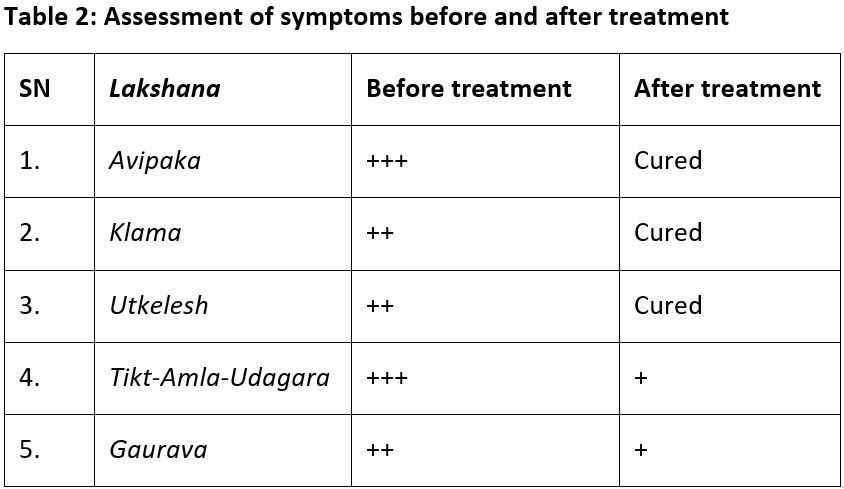Management of Amlapitta with Vasadi Dashanga Vati - A Case Study
DOI:
https://doi.org/10.21760/jaims.10.6.53Keywords:
Amlapitta, Vasadi Dashanga Vati, Case Study, Hyperacidity, Gastritis, Gastroesophageal Reflux Disease (GERD), Peptic Ulcer Disease (PUD)Abstract
Amlapitta is a common gastrointestinal disorder described in Ayurveda, characterized by an imbalance in the Pitta dosha, primarily due to improper diet, stress, and lifestyle habits. It correlates with conditions like hyperacidity or acid peptic disorders in modern medicine. The disease manifests through symptoms such as sour belching, heartburn, nausea, indigestion, and a burning sensation in the stomach and chest. Ayurveda attributes its pathogenesis to aggravated Pitta affecting the digestive fire (Agni) and the gastric secretions. Management involves dietary modifications, lifestyle changes, and the use of herbal formulations like Vasadi-Dashanga Vati. The contents of Vasadi-Dashanga Vati are Vasa, Amrita, Parpata, Nimba, Bhunimba, Markava, Haritaki, Bibhitaki, Amalaki, Kulaka. All drugs have a property of Pitta-shamaka, reduces burning, improves digestion, supports liver function and regulate Pachaka Pitta, also controls acid secretion in the stomach. Improves digestive fire (Agni) in a balanced way, without aggravating Pitta, thus aiding in proper digestion and reducing Ama (toxins).
Downloads
References
Chandra Moorthy H. Madhavanidana with Madhukosha commentary. Varanasi: Chaukambha Sanskrit Series Office; 2009. p. 142.
Vagbhata. Astangahrdaya, Nidanasthana (12/1), with Sarvangasundara commentary by Arunadutta. 7th ed. Varanasi: Chaukhambha Orientalia; 1982. p. 513.
Tiwari PV. Kasyapa Samhita, Khila Sthana (16/44). 2nd ed. Varanasi: Chaukambha Viswabharati; 2002. p. 631.
Madhavakara. Madhava Nidana (51/2), with Madhukosha Sanskrit commentary by Shrivijayarakshita & Shrikanthadatta and Vidyotini Hindi commentary by Sudarshana Shastri. 26th ed. Varanasi: Chaukhambha Sanskrit Sansthan; 1992. p. 171.
Bhishagacharya S. Kashyapa Samhita, Khilstana (16/7-10), Hindi commentary. Reprint ed. Varanasi: Chaukhambha Sanskrit Series; 2013.
Chakrapanidatta. Chakradatta (52/11), with Vaidyaprabha Hindi commentary by Tripathi ID. Varanasi: Chaukhambha Sanskrit Sansthan; 1992. p. 296.
Singh SK, Patel JR, Dangi A, Bachle D, Kataria RK. A complete review on Adhatoda vasica, a traditional medicinal plant. J Med Plants. 2017;5(1):175–80.
Singh SS, Pandey SC, Srivastava S, Gupta VS, Patro B, Ghosh AC. Chemistry and medicinal properties of Tinospora cordifolia (Guduchi). Indian J Pharmacol. 2003;35:83–91.
Pandey G. Dravya Guna Vigyana. Vol. 2. 1st ed. Varanasi: Krishnadas Academy; 2001. p. 691.
Singh PK, Roy S, Dey S. Antimicrobial activity of Andrographis paniculata. Fitoterapia. 2003;74:692–4.
Verma RK, Singh HN, Thakur AK, Kohli SJ. Ethnobotanical survey of medicinal and aromatic plants of Bhagalpur region. Int J Appl Sci Biotechnol. 2020;8:216–22.
Jha AK, Sit N. Methods of extraction of bioactive compounds from Terminalia chebula (Haritaki) and their application in food and pharmaceutical industry: A review. Food Bioeng. 2023;2:139–50. https://doi.org/10.1002/fbe2.12053
Ghosal S, Tripathi VK, Chauhan S. Active constituents of Emblica officinalis. Part 1: Chemistry and antioxidant effects of emblicanin A and B. Indian J Chem. 1996;35:941–8.
Sangeetha G, Srinivas P, Singh HS, Debasish B, Bharathi LK. Fruit and vine rot of pointed gourd (Trichosanthes dioica Roxb.) influenced by planting systems and weather parameters in East Coast region of India. J Pure Appl Microbiol. 2016;10:2895–900.















